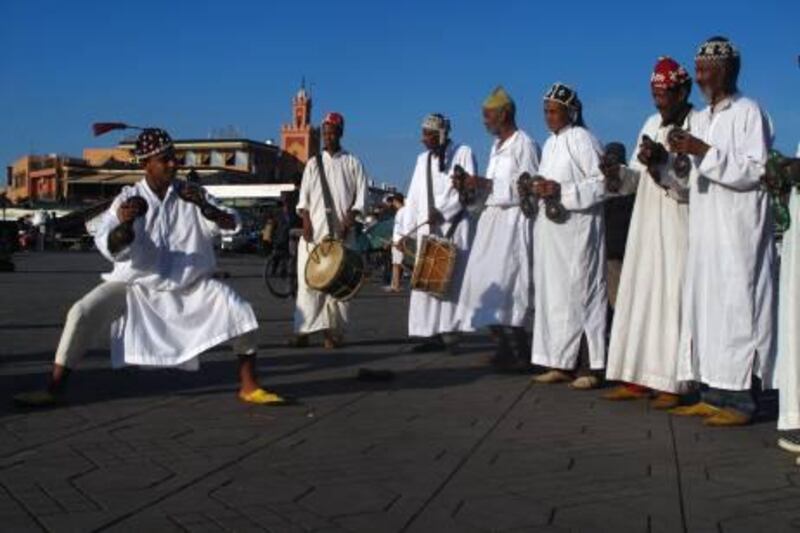'Hello, my friend, would you like to ..." It was the tout's opening line, but I'm not even sure he completed it. "Don't just ignore me!" he snapped. "You could at least respond!" The man stormed off in a huff, a bizarre approach for somebody trying to do business. I'm not even sure what he was offering.
It's business as usual in Morocco. In Rabat, I secured my Mauritanian and Malian visas in a single day and hopped on a train to Marrakech to continue my route down the west coast of Africa, from Madrid to Marrakech to Dakar and then into Mali, getting an all-too-superficial glance at life along the path. Built in 2008, Marrakech's new railway station, the southern terminus of Morocco's rail network, is equipped with free Wi-Fi and gleams like a Dubai hotel lobby. But one thing that hasn't changed is the country's reputation for hassle.
I'm relaxing at a street cafe near Marrakech's Djemaa el-Fna, the sprawling main square and public circus, catching up with my friend Dan, another long-term traveller. Djemaa el-Fna is wondrous and overpowering, a simmering pot of snake charmers, wailing oboes, dancers and acrobats, plus steaming food stalls, tea houses and, for accommodation, both cheap, comfortable guest houses and sumptuous riads. Everything you've ever associated with ye olde exotick Orient is here, all wrapped up in a user-friendly package. It's obvious how Marrakech became the it-city of chic Europeans.
I'd first met Dan this year, half a world away, climbing a mountain in Sichuan province, China. Like others before us, we've both observed that harassment of tourists is probably as bad in Morocco, if not worse, than anywhere else in the world. It's an oft-heard complaint that needs to be tempered in a country as where daily kindnesses outnumber the occasional ugly remarks from angry shopkeepers who act as though you've done them wrong by not buying their trinkets.
Still, it often seems the aggressive pursuit of tourist cash is achieving the opposite of its intended affect in Morocco. In at least one magazine report, hotel owners blamed street hustlers for driving business away, with some visitors claiming they'll never return. One could blame high unemployment among the youth coupled with an influx of foreign visitors, but the same conditions exist in other countries without the undercurrent of aggression.
Like an old arch-imperialist, I've been doing some armchair theorising. "Morocco is the China of North Africa," declared James Richardson in his Travels in Morocco, published posthumously in 1859. A word of caution: this is a awful book, laden with colonialist jargon that characterised so much European writing about Africa in the 19th century, written with the policy aim of forcing these lands to open to European capital and labour.
That said, Richardson makes some interesting observations. "The grand political maxim of the Shereefian Court is, the exclusion of strangers; to look upon all strangers with distrust and suspicion; and should they, at any time, attempt to explore the interior of Morocco, or any of the adjacent counties, to thwart and circumvent their enterprise, is a veritable feat of statesmanship in the opinion of the Shereefian Court."
On the surface, the contrast with today's Morocco could hardly be greater. Even in the past 10 years, changes in Moroccan property law have seen a new class of monied French and British expatriates re-enacting Arabian Nights' fantasies by buying up and renovating crumbling Marrakech riads.
Perhaps it's too glib to link the angry attitude of some tourist touts with an historical aversion to outsiders, but you do feel a pull in two opposing directions here: a country welcoming of foreigners' cash, it simultaneously seems resentful, at times, of their very presence.
Much as I'd love to explore the topic further, even enduring the abuse of irate street hustlers to do so, I'm drawn further south - towards Timbuktu, Marrakech's corresponding "port" city on the opposite side of that great sea of sand, the Sahara. The Tiskiwin Museum, close to Marrakech's Bahia Palace, displays a collection of artefacts from the old caravan trail that shows what Marrakech was before it became a fashionable travel destination: a gateway to the desert, which begins on the other side of the snow-capped Atlas Mountains visible from the medina rooftops.
Back in the 19th century, for an outsider to explore the interior of Morocco was one thing; to reach Timbuktu, the fabled city of gold where the desert meets the Niger River, was something else entirely, and it was not until 1828 that a European finally did so and returned alive. Today, the route across the Sahara is closed to travellers because of unrest among the Tuareg nomads in the region. My path will go the long way around, down the coast of Western Sahara, through Mauritania and Senegal. Perhaps there will be fewer interrupting touts; for certain there will be no Wi-Fi-equipped train stations along the way.
Scott MacMillan is blogging about his journey on his website, www.wanderingsavage.com





